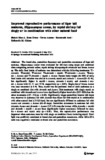Improved reproductive performance of tiger tail seahorse, Hippocampus comes, by mysid shrimp fed singly or in combination with other natural food

View/Open
Date
2015Page views
369Metadata
Show full item recordCited times in Scopus
- Citations
- CrossRef - Citation Indexes: 4
- Scopus - Citation Indexes: 11
- Captures
- Mendeley - Readers: 48
- Mentions
- News: 1
Share
Abstract
The brood size, parturition frequency and parturition occurrence of tiger tail seahorse, Hippocampus comes were evaluated for 180 days using single and combined diets comprising Artemia salina, mysid shrimp Mesopodopsis orientalis and frozen Acetes sp. The daily food intake of seahorse was determined with the following treatments: T1-Artemia; T2-mysid; T3-Acetes; T4-Artemia + mysid; T5-Artemia + Acetes ; T6-mysid + Acetes; and T7-Artemia + mysid + Acetes. Percent body weight (% BW) of daily food intake until satiation was similar in Artemia, mysid and Artemia + Acetes (20-22 %), but significantly higher in mysid + Acetes, Artemia + mysid, and Artemia + mysid + Acetes with 25, 31 and 33 %, respectively (p < 0.05). Single diet of frozen Acetes was least consumed at 6 %. Thus, mysid was the preferred food of adult seahorses as a single or combined diet with Artemia and Acetes. Diet treatments with single mysid or combined with Artemia and Acetes have significantly higher brood size (223-292) than the other treatments (107-152) (p < 0.05). Significantly longer parturition interval (60 days) was observed in seahorses fed with Artemia than those fed with mysid or in combination with other natural food (13-26 days), but not significantly different to seahorses fed with Acetes and Artemia + Acetes (42-45 days). Parturition occurrence in seahorse fed with Artemia, Acetes and Artemia + Acetes (2.7-4.3) were the lowest, while Artemia + mysid and Artemia + mysid + Acetes have significantly higher occurrence followed by mysids + Acetes and mysid only (p < 0.05). Thus, the reproductive performance was improved when seahorses were fed with single or combined foods including mysid. Total lipid was positively correlated to brood size and parturition occurrence, while DHA:EPA ratio was negatively correlated to brood size and parturition occurrence.
Suggested Citation
Buen-Ursua, S. M. A., Azuma, T., Arai, K., & Coloso, R. M. (2015). Improved reproductive performance of tiger tail seahorse, Hippocampus comes, by mysid shrimp fed singly or in combination with other natural food. Aquaculture International , 23(1), 29-43. https://doi.org/10.1007/s10499-014-9795-1
Subject
Taxonomic term
Collections
- AQD Journal Articles [1248]

